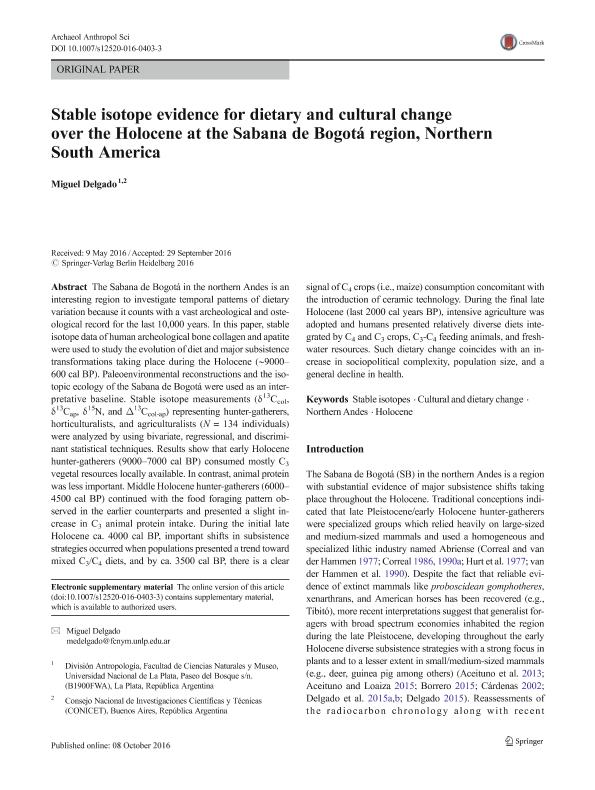Mostrar el registro sencillo del ítem
dc.contributor.author
Delgado Burbano, Miguel Eduardo

dc.date.available
2018-08-13T18:42:43Z
dc.date.issued
2018-06
dc.identifier.citation
Delgado Burbano, Miguel Eduardo; Stable isotope evidence for dietary and cultural change over the Holocene at the Sabana de Bogotá region, Northern South America; Springer; Archaeological and Anthropological Sciences; 10; 4; 6-2018; 817-832
dc.identifier.issn
1866-9557
dc.identifier.uri
http://hdl.handle.net/11336/55179
dc.description.abstract
The Sabana de Bogotá in the northern Andes is an interesting region to investigate temporal patterns of dietary variation because it counts with a vast archeological and osteological record for the last 10,000 years. In this paper, stable isotope data of human archeological bone collagen and apatite were used to study the evolution of diet and major subsistence transformations taking place during the Holocene (∼9000–600 cal BP). Paleoenvironmental reconstructions and the isotopic ecology of the Sabana de Bogotá were used as an interpretative baseline. Stable isotope measurements (δ13Ccol, δ13Cap, δ15N, and Δ13Ccol-ap) representing hunter-gatherers, horticulturalists, and agriculturalists (N = 134 individuals) were analyzed by using bivariate, regressional, and discriminant statistical techniques. Results show that early Holocene hunter-gatherers (9000–7000 cal BP) consumed mostly C3 vegetal resources locally available. In contrast, animal protein was less important. Middle Holocene hunter-gatherers (6000–4500 cal BP) continued with the food foraging pattern observed in the earlier counterparts and presented a slight increase in C3 animal protein intake. During the initial late Holocene ca. 4000 cal BP, important shifts in subsistence strategies occurred when populations presented a trend toward mixed C3/C4 diets, and by ca. 3500 cal BP, there is a clear signal of C4 crops (i.e., maize) consumption concomitant with the introduction of ceramic technology. During the final late Holocene (last 2000 cal years BP), intensive agriculture was adopted and humans presented relatively diverse diets integrated by C4 and C3 crops, C3-C4 feeding animals, and freshwater resources. Such dietary change coincides with an increase in sociopolitical complexity, population size, and a general decline in health.
dc.format
application/pdf
dc.language.iso
eng
dc.publisher
Springer

dc.rights
info:eu-repo/semantics/openAccess
dc.rights.uri
https://creativecommons.org/licenses/by-nc-sa/2.5/ar/
dc.subject
Cultural And Dietary Change
dc.subject
Holocene
dc.subject
Northern Andes
dc.subject
Stable Isotopes
dc.subject.classification
Historia

dc.subject.classification
Historia y Arqueología

dc.subject.classification
HUMANIDADES

dc.title
Stable isotope evidence for dietary and cultural change over the Holocene at the Sabana de Bogotá region, Northern South America
dc.type
info:eu-repo/semantics/article
dc.type
info:ar-repo/semantics/artículo
dc.type
info:eu-repo/semantics/publishedVersion
dc.date.updated
2018-08-13T14:37:07Z
dc.identifier.eissn
1866-9565
dc.journal.volume
10
dc.journal.number
4
dc.journal.pagination
817-832
dc.journal.pais
Alemania

dc.journal.ciudad
Berlín
dc.description.fil
Fil: Delgado Burbano, Miguel Eduardo. Consejo Nacional de Investigaciones Científicas y Técnicas. Centro Científico Tecnológico Conicet - La Plata; Argentina. Universidad Nacional de La Plata. Facultad de Ciencias Naturales y Museo. Área Antropológica; Argentina
dc.journal.title
Archaeological and Anthropological Sciences
dc.relation.alternativeid
info:eu-repo/semantics/altIdentifier/url/http://link.springer.com/article/10.1007/s12520-016-0403-3
dc.relation.alternativeid
info:eu-repo/semantics/altIdentifier/doi/http://dx.doi.org/10.1007/s12520-016-0403-3
Archivos asociados
